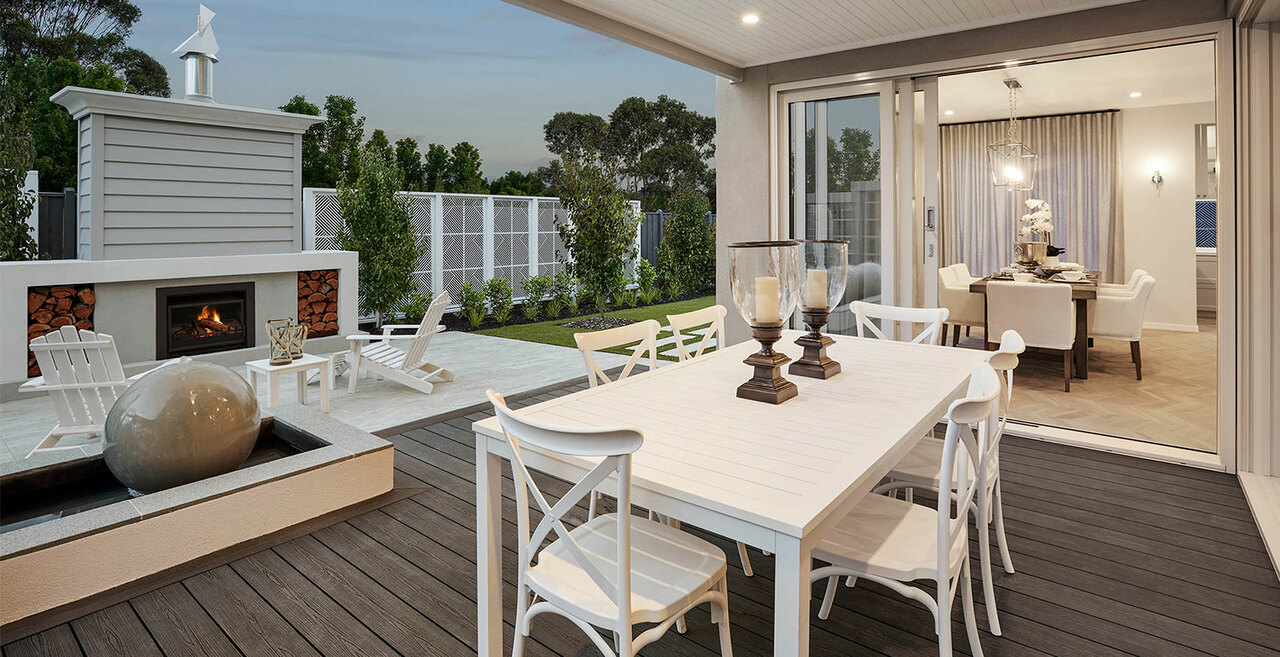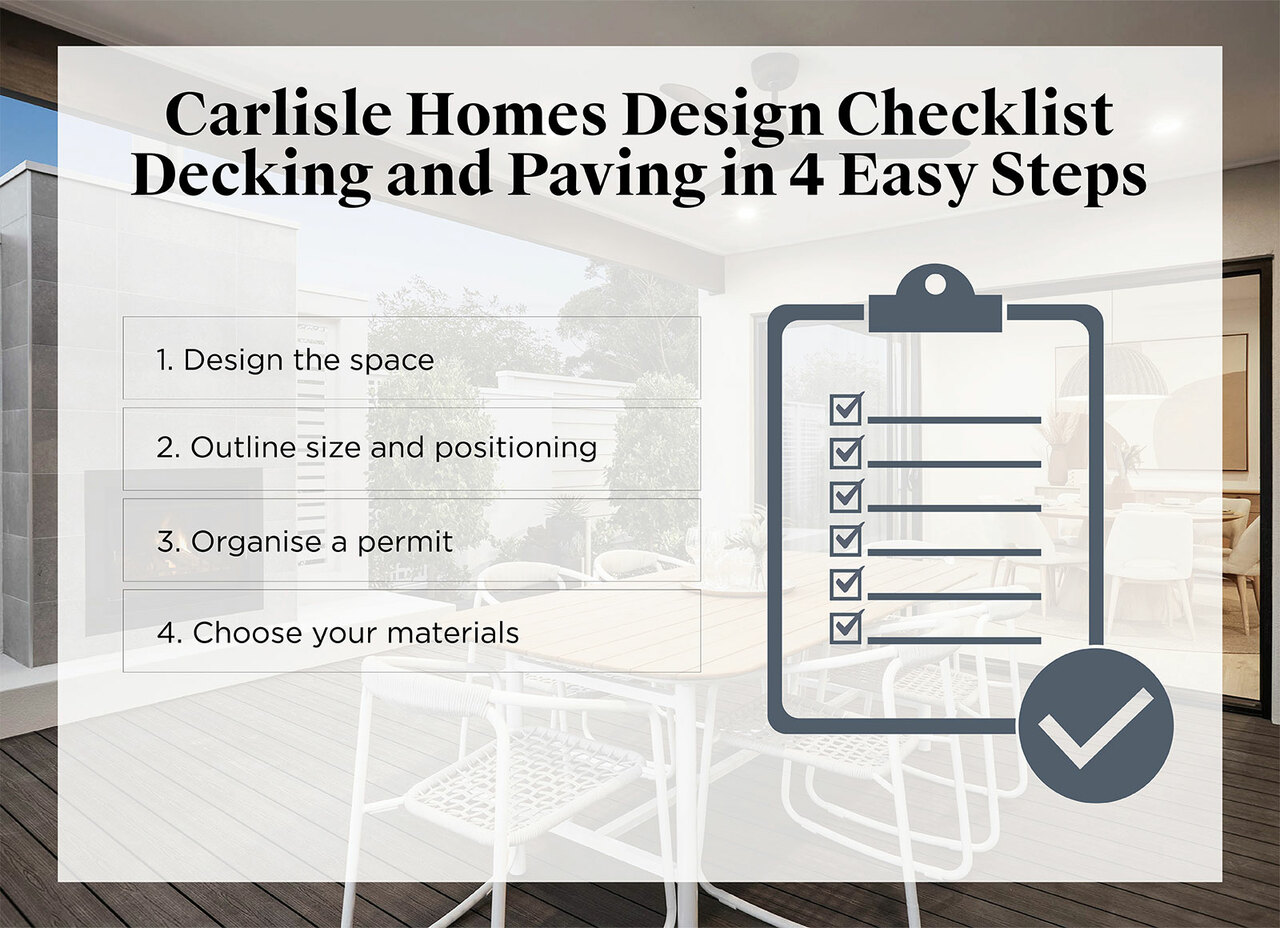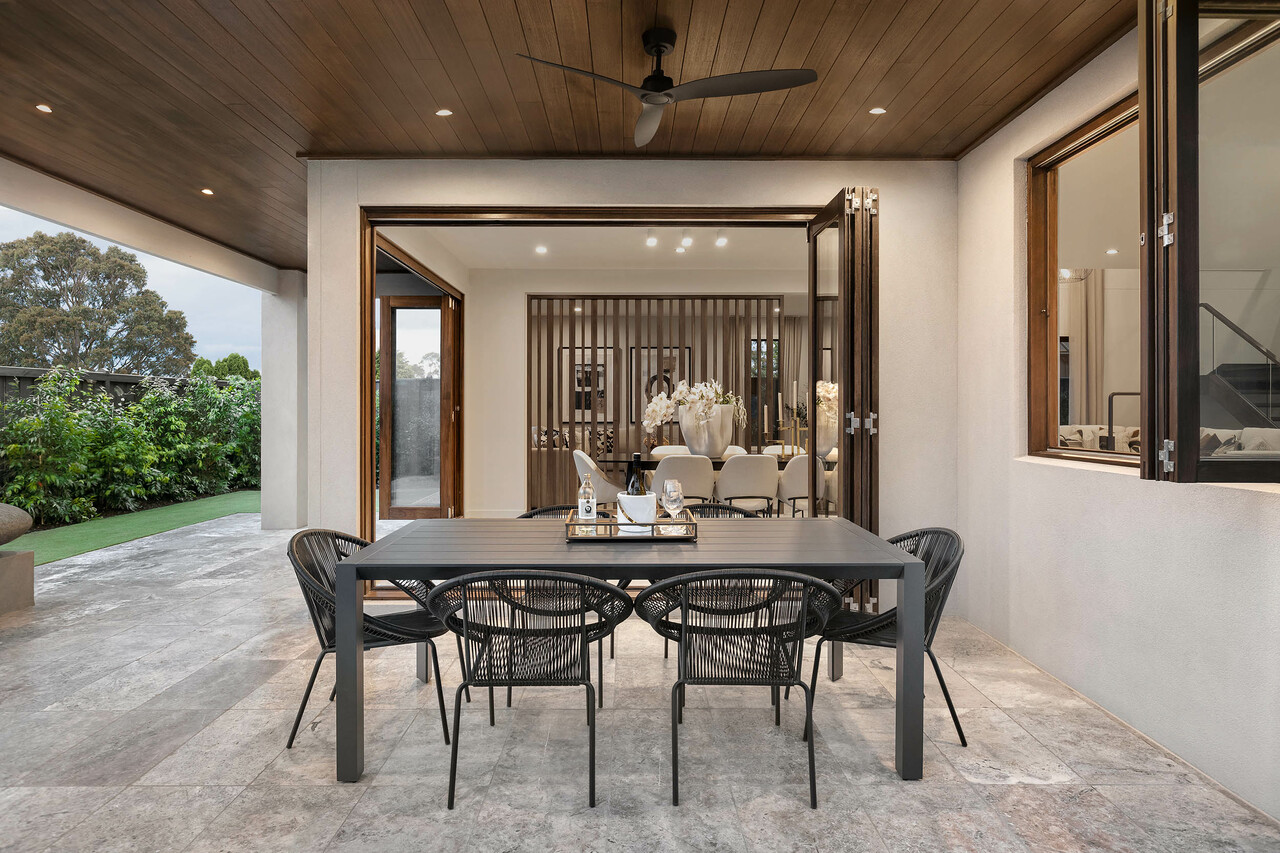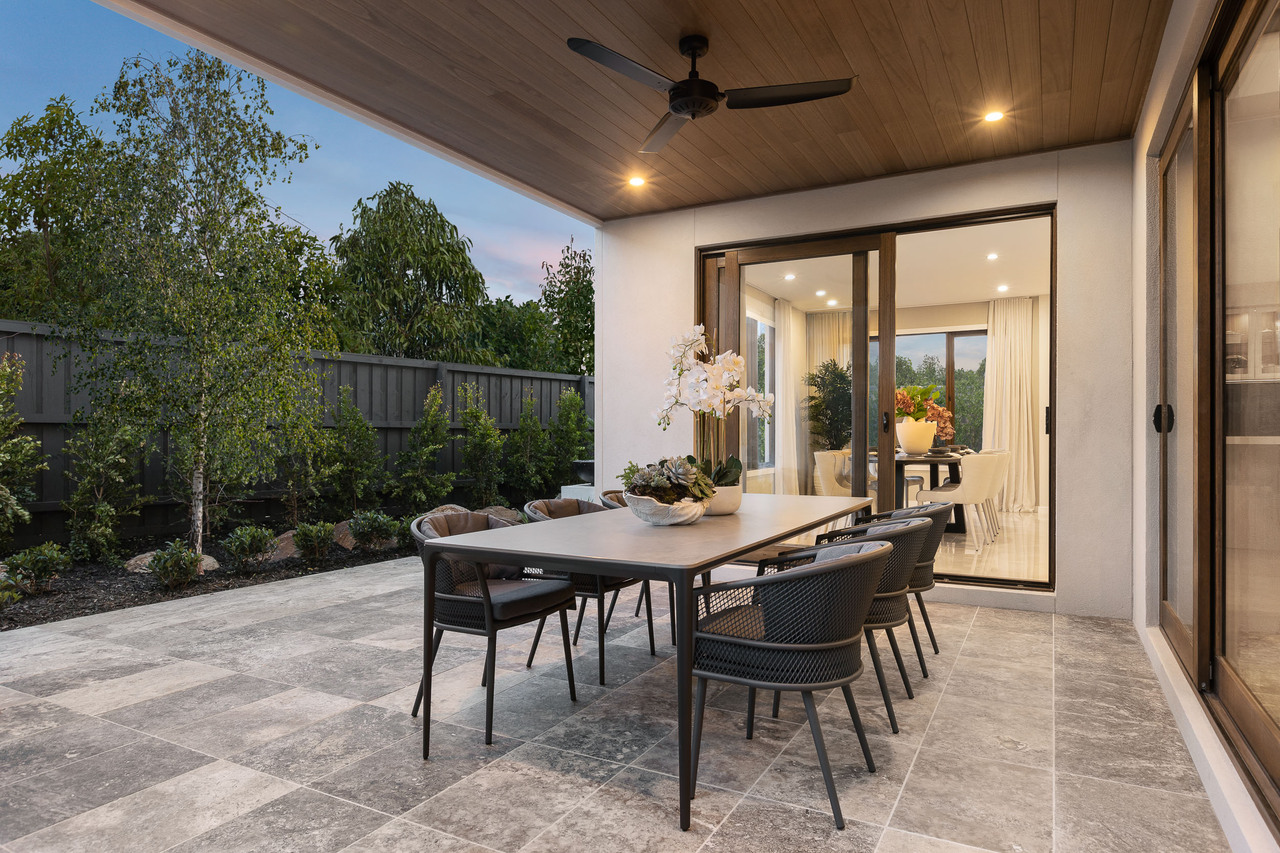Decking And Paving FAQs
by Ricky D'Alesio, Senior Designer

The right decking and pavers can elevate your home’s exterior and reduce the amount of maintenance required – here’s what you need to know.
Adding a deck or laying pavers is a great way to increase your home’s usable space. It immediately gives you somewhere to set up a dining table or an alfresco sofa and entertain outdoors (or simply relax and enjoy the sunshine).
In this Home Design Checklist post, we cover the most important things you need to know about installing decking and pavers into your outdoor living space.

A guide to decking and paving for your home in four easy steps!
Do you need a permit to put in a deck?
It depends on the situation. If you are building a deck over an existing porch or an alfresco concrete slab, you don’t need a permit. But once you exceed their original size by two square metres or more, you will need to get a permit.
It’s also important to note:
- You can’t run a deck over the top of an easement.
- Decks need to be located at least one metre away from your lot’s boundary lines.
- Spacing for decking joists will vary depending on the thickness of the decking boards used. For decking boards up to 19mm thick, joist decking should not exceed 450mm. For decking boards between 19mm and 32mm thick, decking spacing should not exceed 600mm. However, these are general guidelines and specific requirements can vary based on timber used, expected load and local building regulations.
Do you need a permit to lay pavers?
No, you generally don’t need a permit to add pavers. Unlike decking boards, paving doesn’t have footings.
It’s also good to know that you can pour a concrete paving slab over an easement and closer than one metre from a boundary without getting a permit. However, be aware that if authorised service providers need access to the easement, they are allowed to rip up your paving to access things such as pipes and underground cables.

Be aware that unlike pavers, your plans for decking cannot run over easements or within one metre from the house’s boundary lines. Featured here: Canterbury Grand Deluxe Atrium, Berwick Waters Estate, Clyde North.
How to prepare your ground for decking
To prepare your ground for decking, start by clearing the area of any grass, weeds, and debris. Next, level the ground and ensure it has a slight slope away from any structures to promote proper drainage. Lay down a weed barrier fabric to prevent future weed growth. Mark the perimeter of your deck and install string lines to outline the area. Excavate post holes and set the posts in concrete for a sturdy foundation. Finally, add a layer of gravel for additional drainage and compact it before beginning the deck frame construction. Proper ground preparation ensures a stable, long-lasting deck.
What are the main options in decking materials?
The decking material you choose will affect the aesthetics of your outdoor area and its maintenance costs.
The most common options when upgrading your property and outdoor space are:
Solid timber: Real timber decking, such as Merbau, Spotted Gum or Cypress Pine, adds warmth and natural appeal to your outdoor area when stained. However, timber decks require twice-yearly oiling to prevent it from discolouring or deteriorating (less so if it’s covered by a roof).
It’s important to keep moisture away from timber by laying decking at least 40-50mm away from a concrete slab it's laid on to provide sufficient airflow underneath it.
Composite: Timber-look composite decking, made from recycled plastic and wood shavings, comes prefinished and doesn’t require the upkeep of the real thing. It does cost more upfront than solid timber deck boards, but savings in regular maintenance can be costly.
Composite decking boards vary in quality and appearance, so do your research before you buy. In particular, assess how the product weathers over time, as some tend to fade and can look quite fake (most manufacturers have images on their websites showing how the product weathers). Also, check if there are sealer coatings available to keep the product looking its best.
Fibre cement: Fibre cement product decking is the most durable option for outdoor areas, plus it’s more cost-effective than composite decks. It is moisture and fade-resistant, can stand up to weather extremes, and requires less resealing than natural timber. It’s also splinter-free, which can be an advantage if you have young children. You can stain or paint fibre cement decking but be aware that it has a somewhat flat appearance at ground level, without the grain of natural timber.
Tiles: Porcelain, ceramic, concrete and natural stone tiles are all durable and low-maintenance choices for outdoors. But be aware that they will need to be laid over a concrete base to limit movement and cracking over time. At Carlisle Homes, we recommend a concrete base for all our external balcony tiling and paving to limit future movement (although it can still occur) and we ensure that the paving falls away from the home to stop water ponding near footings.

What decking you decide to go with will determine not only the aesthetics of your outdoor spaces, but the maintenance required to keep them looking great. Featured here: Sorrento Grand Deluxe Theatre Atrium, Bankside Estate, Rowville.
What are the different types of timber decking?
Choosing the right timber for your decking project is crucial, as it not only impacts the aesthetic appeal of your outdoor space but also its durability and maintenance. In Australia, Merbau, Spotted Gum, and Blackbutt are three popular choices, each offering unique characteristics. From the rich, warm tones of Merbau to the varied hues of Spotted Gum and the clean, contemporary look of Blackbutt, these timbers provide distinct options to suit different styles and preferences. Understanding their differences in aesthetics and cost can help you make an informed decision that best fits your needs and budget:
Merbau
Merbau is known for its rich brown to reddish-brown hues, offering a warm and inviting aesthetic. It features a moderately coarse, interlocking grain that adds a distinctive texture to any outdoor space. Merbau is a popular choice for those seeking a luxurious and glossy finish, making it a favourite for high-end decking projects. The cost of Merbau typically ranges from AUD $90 to $140 per square metre, making it an affordable option that combines both beauty and durability.
Spotted Gum
Spotted Gum stands out with its wide colour variation, ranging from light brown to dark red-brown, often featuring a mix of colours in a single board. This timber's moderately coarse, wavy grain adds a dynamic and visually appealing texture, enhancing the natural beauty of the wood. Its natural lustre provides a slightly glossy finish, ideal for creating an elegant outdoor space. The cost of Spotted Gum is generally around AUD $100 to $150 per square metre, offering a balance between aesthetic appeal and resilience.
Blackbutt
Blackbutt is prized for its pale brown colour, sometimes accented with subtle pink or yellow tones. It boasts a straight and even grain, providing a smooth and consistent texture that complements modern, clean-lined designs. Blackbutt polishes well, resulting in a sleek and contemporary appearance that appeals to those looking for a refined look. It is typically priced between AUD $110 and $160 per square metre, reflecting its quality and the visual sophistication it brings to decking projects.
No matter which timber decking you’re after, be sure to do your research on costs and quality of the timber - as they can vary significantly by supplier.
What are the main options in pavers?
Natural stone: Travertine, bluestone, limestone, and other natural stone pavers are hardy options for outdoor areas and create a lovely, organic feel. However, sandstone and some limestone options are more porous than other natural stones, prone to leaf and red wine staining, and will most probably require regular sealing.
Concrete: Non-stone pavers, such as concrete, are generally more cost-effective and come in a variety of finishes and sizes to suit different exterior styles, including rustic, tumbled-edge pavers, contemporary, polished pavers, and ones that mimic the look of natural stone. They’re tough, weather and fade-resistant, and will last for decades.
Brick: Clay bricks are extremely hard-wearing and long-lasting, and will add an earthy, textural feel to your alfresco space or front path. Plus, they sit beautifully alongside other natural, high-quality materials such as timber and stone. You can lay them in different patterns to create a distinctive look, too.
Visit a Carlisle display home for decking and paving inspiration today
Step into a world of possibilities by visiting a Carlisle display home for the latest in decking and paving inspiration. Our display homes showcase beautifully designed outdoor spaces, featuring expertly crafted decks and innovative paving solutions that seamlessly blend style and functionality. Explore a variety of materials, layouts, and finishes that can transform your backyard into an inviting oasis.
Whether you’re looking to entertain guests, create a serene retreat, or add value to your property, Carlisle Homes offers the inspiration and expertise to help you bring your vision to life. Visit us today and start planning your dream outdoor space with confidence.
To see all the latest outdoor trends and get ideas for your own home, visit one of our many display homes across Melbourne. It’s also a great opportunity to ask our team any questions you may have about designing your home’s front yard and exterior.

Ricky D'Alesio
Senior Designer
Ricky is passionate about all things design, and loves creating floor plans to suit the needs of all types of customers. His expertise spans across all areas of design, from space planning and ensuring structural integrity to interior floor plans and facade design.
Learn more about Ricky D'Alesio